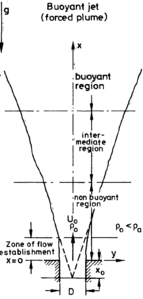Abstr:Axisymmetric buoyant far-field plume
Underlying Flow Regime 1-06
Abstract
PREFACE
This document examines the Underlying Flow Regime (UFR) of a turbulent, axisymmetric, free-plume in a quiescent, unstratified environment. Only the far-field behaviour is considered where the buoyancy-driven plume exhibits self-similar behaviour. Another related QNET-UFR documents the unsteady turbulent behaviour near plume sources.
Turbulent, axisymmetric plumes are a feature of many important scientific and engineering applications including flows generated by smokestacks, cooling towers, fires and large geothermal events, such as volcanoes. The source of the buoyancy may be provided by temperature differences in the fluid or can be related to two fluids of different density mixing together. In some cases, the plumes originate from a source such as a pipe with some initial momentum. These flows, known as forced plumes or buoyant jets, feature jet-like behaviour near the source, a transitional region further downstream and then, even further downstream, fully-developed plume behaviour (see Figure 1).
A brief review is provided in this UFR of experiments and CFD studies of fully-developed axisymmetric plumes. The recent study by Van Maele & Merci[2] , which is considered to be an example of best-practice CFD, is described in more detail. Their work examined the performance of standard and realizable k-ε RANS models against the experimental work of George et al. . It showed that both standard and realizable models combined with the Generalized Gradient Diffusion Hypothesis (GGDH) for the buoyancy production term give reasonable predictions of the mean flow behaviour. The Standard Gradient Diffusion Hypothesis (SGDH) buoyancy model produces too little turbulent mixing and as a consequence underpredicts spreading rates and overpredicts mean centreline values of velocity and temperature/concentration. A brief analysis of the second-moment closure modelling of Malin & Younis is also provided.
Best-practice advice is provided for CFD practitioners on key modelling issues, such as computational grid requirements, the choice of parabolic or elliptic solvers and the use of simplifications, such as the Boussinesq approximation.
There is some uncertainty over the results from recent measurements reported in the literature (see Section 2.3.1). It is recommended that an in-depth review of experiments be undertaken, similar to the comprehensive study made 27 years ago by Chen & Rodi . Further experiments may be necessary to establish beyond doubt the true self-similar behaviour of axisymmetric plumes. The findings of such work could affect the reported accuracy of CFD models.
Contributed by: Dr Simon Gant — '
© copyright ERCOFTAC 2009

